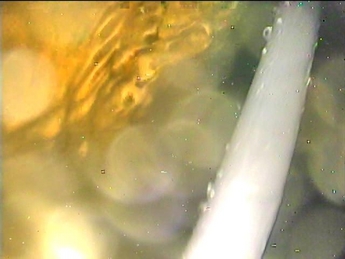A series of measurements inside of the Fukushima Daiichi unit 2 primary containment vessel has made two significant discoveries.

First, it found that radiation levels were extremely high (as high as 73 Sv/hr), and tended to increase the closer the sensor got to the bottom of the vessel. That measurement pattern is consistent with the presence of some amount of melted core materials at the bottom of the PCV. Earlier TEPCO evidence had suggested, based on simulations and the delay of the onset of cooling, that the active core in units 2&3 may not have melted down and out through penetrations in the bottom of the RPV, as TEPCO expected for unit 1.
The measurements were taken by dangling a probe out of a measurement guide pipe located about 2m below the bottom end of the RPV and about 1m into the PCV horizontally. The measurements ranged from 39.0 Sv/hr at that elevation to 54.1 Sv/hr a metre lower, 57.4 Sv/hr a metre lower, and 72.9 about 0.8m below that. The detector was prevented from measuring further by a grating about 9m above the bottom of the PCV. (The dosimeter's maximum reading is 1000 Sv/hr).
Measurements taken closer to the PCV wall (0.5 m) did not tend to increase as the probe reached the bottom of the vessel. They were 39 Sv/hr at the guide pipe level, 48 Sv/hr one metre below, and then 41.4 Sv/hr one metre below that, and finally 37.3 Sv/hr 0.8m below that. However, drawings suggest that the last two measurements were taken on one side of a terminal box, which would block some radiation coming from a source in the centre bottom of the PCV.
The probe also detected a pool of about 60cm of water at the bottom of the PCV, which, at about 50°C, was not in danger of immediate boil-off. The presence of at least some relatively cool water is significant because it suggests that if there is melted corium in the PCV, it is being adequately cooled. An NHK news report republished by Japan Atomic Industrial Forum's Atoms In Japan service said that TEPCO had thought that the water level was five times higher, 3m. The fact that less water was found than expected might indicate a greater amount of leaking than previously thought. In the RPV, about 6.0 m3/hr is being injected through the core spray line, and 2.8 m3/hr through the feedwater system. Video evidence shows sediment in the water, which appears a rust-coloured orange.
Related ArticlesUK's Horizon completes purchase of land for nuclear development E.On pulls out of Fennovoima and Finnish nuclear project Horizon signs early work agreements with Areva and Westinghouse New nuclear on UK horizon Jacobs to continue environmental work for Horizon




